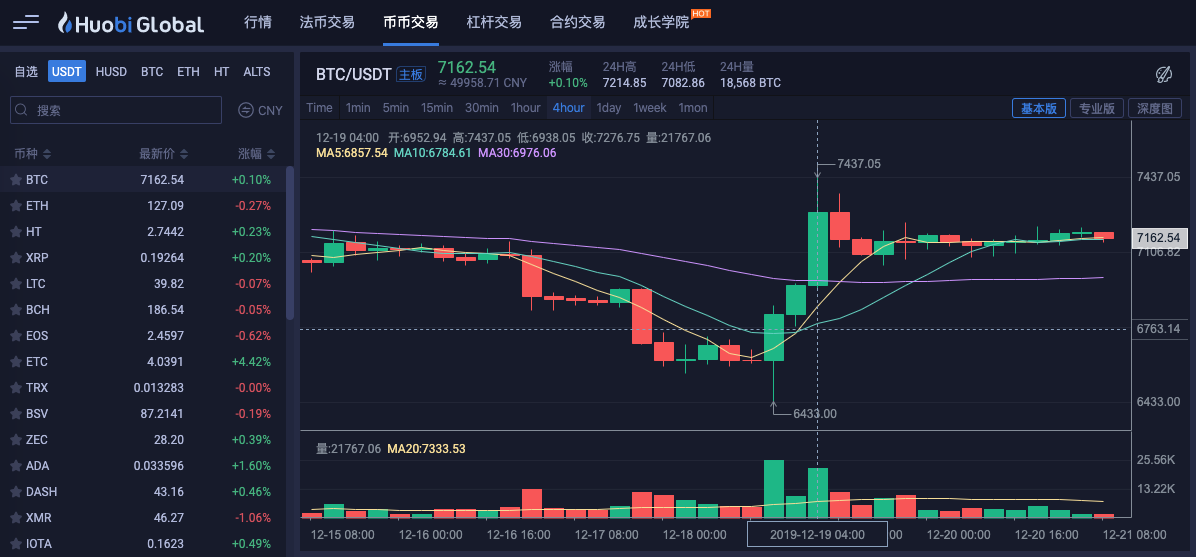La mano te enseñará a escribir una función de síntesis de K-line en Python.
El autor:Los inventores cuantifican - sueños pequeños, Creado: 2019-12-21 09:38:26, Actualizado: 2024-12-15 15:59:54
La mano te enseñará a escribir una función de síntesis de K-line en Python.
Cuando se escriben y usan políticas, se suele usar un poco de datos de ciclos de línea K poco usados. Sin embargo, los intercambios y las fuentes de datos no ofrecen datos de estos ciclos. Solo se puede sintetizar utilizando datos ya ciclados.EnlacesEn la versión de Python, es muy sencillo. A continuación, vamos a escribir juntos un algoritmo de síntesis de K-line para una versión de Python.
Versión de JavaScript
function GetNewCycleRecords (sourceRecords, targetCycle) { // K线合成函数
var ret = []
// 首先获取源K线数据的周期
if (!sourceRecords || sourceRecords.length < 2) {
return null
}
var sourceLen = sourceRecords.length
var sourceCycle = sourceRecords[sourceLen - 1].Time - sourceRecords[sourceLen - 2].Time
if (targetCycle % sourceCycle != 0) {
Log("targetCycle:", targetCycle)
Log("sourceCycle:", sourceCycle)
throw "targetCycle is not an integral multiple of sourceCycle."
}
if ((1000 * 60 * 60) % targetCycle != 0 && (1000 * 60 * 60 * 24) % targetCycle != 0) {
Log("targetCycle:", targetCycle)
Log("sourceCycle:", sourceCycle)
Log((1000 * 60 * 60) % targetCycle, (1000 * 60 * 60 * 24) % targetCycle)
throw "targetCycle cannot complete the cycle."
}
var multiple = targetCycle / sourceCycle
var isBegin = false
var count = 0
var high = 0
var low = 0
var open = 0
var close = 0
var time = 0
var vol = 0
for (var i = 0 ; i < sourceLen ; i++) {
// 获取 时区偏移数值
var d = new Date()
var n = d.getTimezoneOffset()
if (((1000 * 60 * 60 * 24) - sourceRecords[i].Time % (1000 * 60 * 60 * 24) + (n * 1000 * 60)) % targetCycle == 0) {
isBegin = true
}
if (isBegin) {
if (count == 0) {
high = sourceRecords[i].High
low = sourceRecords[i].Low
open = sourceRecords[i].Open
close = sourceRecords[i].Close
time = sourceRecords[i].Time
vol = sourceRecords[i].Volume
count++
} else if (count < multiple) {
high = Math.max(high, sourceRecords[i].High)
low = Math.min(low, sourceRecords[i].Low)
close = sourceRecords[i].Close
vol += sourceRecords[i].Volume
count++
}
if (count == multiple || i == sourceLen - 1) {
ret.push({
High : high,
Low : low,
Open : open,
Close : close,
Time : time,
Volume : vol,
})
count = 0
}
}
}
return ret
}
Hay algoritmos de JavaScript que pueden ser portados para Python, en realidad, por línea de traducción, encontrando funciones integradas de JavaScript, o métodos intrínsecos, que buscan el método correspondiente en Python, por lo que el transporte es más fácil.
La lógica del algoritmo es exactamente la misma, sólo las llamadas de funciones de JavaScript.var n = d.getTimezoneOffset()En el caso de las aplicaciones de tiempo de Python, las aplicaciones de tiempo de Python pueden ser utilizadas en el archivo de tiempo.n = time.altzoneLas otras diferencias son meramente gramaticales (por ejemplo, el uso de la circunferencia for, la diferencia entre el valor de Boole, la diferencia entre la lógica y la lógica no, la lógica o la diferencia entre la lógica y la lógica).
El código de Python trasplantado:
import time
def GetNewCycleRecords(sourceRecords, targetCycle):
ret = []
# 首先获取源K线数据的周期
if not sourceRecords or len(sourceRecords) < 2 :
return None
sourceLen = len(sourceRecords)
sourceCycle = sourceRecords[-1]["Time"] - sourceRecords[-2]["Time"]
if targetCycle % sourceCycle != 0 :
Log("targetCycle:", targetCycle)
Log("sourceCycle:", sourceCycle)
raise "targetCycle is not an integral multiple of sourceCycle."
if (1000 * 60 * 60) % targetCycle != 0 and (1000 * 60 * 60 * 24) % targetCycle != 0 :
Log("targetCycle:", targetCycle)
Log("sourceCycle:", sourceCycle)
Log((1000 * 60 * 60) % targetCycle, (1000 * 60 * 60 * 24) % targetCycle)
raise "targetCycle cannot complete the cycle."
multiple = targetCycle / sourceCycle
isBegin = False
count = 0
barHigh = 0
barLow = 0
barOpen = 0
barClose = 0
barTime = 0
barVol = 0
for i in range(sourceLen) :
# 获取时区偏移数值
n = time.altzone
if ((1000 * 60 * 60 * 24) - (sourceRecords[i]["Time"] * 1000) % (1000 * 60 * 60 * 24) + (n * 1000)) % targetCycle == 0 :
isBegin = True
if isBegin :
if count == 0 :
barHigh = sourceRecords[i]["High"]
barLow = sourceRecords[i]["Low"]
barOpen = sourceRecords[i]["Open"]
barClose = sourceRecords[i]["Close"]
barTime = sourceRecords[i]["Time"]
barVol = sourceRecords[i]["Volume"]
count += 1
elif count < multiple :
barHigh = max(barHigh, sourceRecords[i]["High"])
barLow = min(barLow, sourceRecords[i]["Low"])
barClose = sourceRecords[i]["Close"]
barVol += sourceRecords[i]["Volume"]
count += 1
if count == multiple or i == sourceLen - 1 :
ret.append({
"High" : barHigh,
"Low" : barLow,
"Open" : barOpen,
"Close" : barClose,
"Time" : barTime,
"Volume" : barVol,
})
count = 0
return ret
# 测试
def main():
while True:
r = exchange.GetRecords()
r2 = GetNewCycleRecords(r, 1000 * 60 * 60 * 4)
ext.PlotRecords(r2, "r2")
Sleep(1000)
Las pruebas
Gráfico de las monedas
Reinvestigación de gráficos de 4 horas
El código anterior se utiliza sólo como referencia de aprendizaje, si se utiliza en una estrategia específica, modifique o pruebe según las necesidades. Si tiene algún error o sugerencia de mejoras, bienvenido a dejar un comentario, muchas gracias o^_^o
- Introducción al arbitraje de lead-lag en criptomonedas (2)
- Introducción al conjunto de Lead-Lag en las monedas digitales (2)
- Discusión sobre la recepción de señales externas de la plataforma FMZ: una solución completa para recibir señales con servicio HTTP incorporado en la estrategia
- Exploración de la recepción de señales externas de la plataforma FMZ: estrategias para una solución completa de recepción de señales de servicios HTTP integrados
- Introducción al arbitraje de lead-lag en criptomonedas (1)
- Introducción al conjunto de Lead-Lag en las monedas digitales (1)
- Discusión sobre la recepción de señales externas de la plataforma FMZ: API extendida VS estrategia Servicio HTTP incorporado
- Exploración de la recepción de señales externas de la plataforma FMZ: API de expansión vs estrategia de servicio HTTP incorporado
- Discusión sobre el método de prueba de estrategias basado en el generador de tickers aleatorios
- Explorar métodos de prueba de estrategias basados en generadores de mercado aleatorios
- Nueva característica de FMZ Quant: Utilice la función _Serve para crear servicios HTTP fácilmente
- Estrategia de negociación de tasas cuantitativas
- La estrategia de equilibrio de la plataforma de Python
- El viaje de un viejo campesino en el pozo
- La autobiografía de un monero post-95
- La mano a la mano te enseña cómo cambiar la política de una sola variedad en Python a una política de varias variedades.
- Mi pérdida automática y mi viaje a FMZ
- FMZ trayectoria del corazón - estrategia de salto incluida
- La estrategia de persecución de Python
- Políticas de red sencillas en Python
- Opciones de divisas digitales para el comercio cuantificado de la caja abierta
- La mano te enseñará a añadir más gráficos a la política
- Estrategia de suspensión lineal basada en funciones de reproducción de datos
- La mano te enseña a trasplantar una estrategia de lenguaje (progreso)
- Iniciación a las transacciones cuantitativas de monedas digitales
- Guía de uso de estrategias de minería FMex cuantificadas por los inventores
- Estrategias de cobertura entre monedas en transacciones de activos cuantificados en blockchain
- Modificación de la API de futuros de Deribit para adaptarse a las operaciones cuantificadas de opciones
- La mano te enseñará a escribir estrategias -- una estrategia de mi lengua.
- Análisis de los detalles del triángulo de cobertura y el impacto de las tarifas de tramitación en los precios de diferenciación de cobertura con el uso del entorno de investigación
- Introducción del entorno de investigación en ciencia de datos cuánticos FMZ
La homilía/upload/asset/30da6ebb64b8003b1686.jpg Ah, el maestro Dream Dream tiene más tecnología que yo.
La homilíaLa función pyresample está en una línea.
Los inventores cuantifican - sueños pequeñosZhan, yo no sé Python, soy un principiante.
Los inventores cuantifican - sueños pequeños666 está aprendiendo.